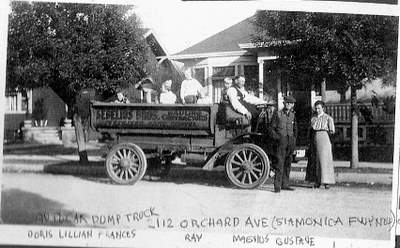| ||||
 Magnus Sebelius and his Autocar Bob recalls:
"The Sebelius brothers, Magnus and Gustave operated a dump-truck service based in the backyard of their houses at 2112 South Orchard Avenue in Los Angeles, California. It was 1925 when my memories of the Autocar Dumptruck (as a 5-year old) began. My father, Thorwald Johnson, was employed as a truckdriver by his uncle Magnus and rented one of Magnus' houses there. The trucks were kept in an open shed in our backyard. I have come to believe that these trucks were cheaply available as surplus government property after the 1918 Armistice.
| "The trucks were painted gray,with solid rubber tires.The engine was under the right side of the drivers upholstered bench, a one cylinder flywheel engine, once started by hand cranking,ran at an RPM determined by a centrifugal governor mechanism controlled as the driver's throttling device. The economy of this engine was its capability of coasting the flywheel without fuel or the resistance of a compression cycle until the governor detected frictional slow-down (remember the interrupted rhythm of the song, "Cement Mixer, Putsy-Putsy"), then allowing the engine fuel and a few compression strokes to restore energy to the flywheel. One truck had a clutch connecting to the rear wheels by a chain drive. There was a power take-off to an oil pump that was piped to a cylinder that tipped the dump-box. A very unique feature was a warning whistle powered by the exhaust stroke cycle. My father told us about how the worn-smooth tread of the solid rubber tires had very little traction on wet asphalt pavements and how once his truck spun downhill into a streetlight pole, where a pedestrian on the sidewalk advised him to "Haul-ass away before the cops come". That night , my father painted his truck red. The top speed of this rig was about 25 MPH. | |||